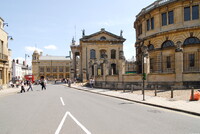| dc.coverage.spatial | Site: University of Oxford (Oxford, England, United Kingdom) | en_US |
| dc.coverage.temporal | 1711-1715 (creation) | en_US |
| dc.creator | Hawksmoor, Nicholas | en_US |
| dc.date | 1711-1715 | en_US |
| dc.date.accessioned | 2013-02-21T21:41:00Z | |
| dc.date.available | 2013-02-21T21:41:00Z | |
| dc.date.issued | 1711-1715 | en_US |
| dc.identifier | 193436 | en_US |
| dc.identifier.other | archrefid: 1397 | en_US |
| dc.identifier.uri | http://hdl.handle.net/1721.3/100766 | |
| dc.description | Context view, looking east, showing the west elevation, with the Sheldonian Theatre at right; The Old Clarendon Building was commissioned to house the two printing companies of Oxford University, one of which made money by producing the Authorized Version of the Bible, the other spending it in producing subsidized works of scholarship. His brief required two virtually separate sets of workrooms linked by a portico, which framed a central passage on the axis of the already standing quadrangle of the Bodleian Library [Schools Quadrangle]. As both a utilitarian structure (though it no longer houses the presses) and an ornament to the University, Hawksmoor's building combined his understanding of the eloquence of plain monumentality with his sensitivity to the detailing of Classical architecture. He provided tetrastyle Doric porticos, prostyle towards the street and applied towards the Library; the rest of the exterior is astylar, except that the entablature of the giant order is carried all the way round. The wall surfaces are articulated and enlivened by changes in plane from bay to bay that also emphasize and exploit the massive thickness of the load-bearing walls. The windows have plain, raised architraves without any of the conventional mouldings, but all the windows in the raised basement and some on the top storey have exaggerated and dropped triple keystones, a motif usually associated with Italian Mannerism but one that Hawksmoor, by producing the boldest examples, made peculiarly his own. Source: Grove Art Online; http://www.oxfordartonline.com/ (accessed 7/15/2008) | en_US |
| dc.format.medium | stone | en_US |
| dc.rights | © Scott Gilchrist, Archivision, Inc. | en_US |
| dc.subject | architectural exteriors | en_US |
| dc.subject | Education | en_US |
| dc.subject | educational | en_US |
| dc.subject | printing | en_US |
| dc.subject | printing presses | en_US |
| dc.subject | Mannerist (Renaissance-Baroque style) | en_US |
| dc.subject | Neoclassical | en_US |
| dc.title | Old Clarendon Building | en_US |
| dc.title.alternative | Bodleian Library; Clarendon Building | en_US |
| dc.title.alternative | University Printing House | en_US |
| dc.type | image | en_US |
| dc.rights.access | Licensed for educational and research use by the MIT community only | en_US |
| dc.identifier.vendorcode | 1A2-E-O-CB-A2 | en_US |
| vra.culturalContext | British | en_US |
| vra.technique | construction (assembling) | en_US |
| vra.worktype | studio (work space) | en_US |
| vra.worktype | factory (structure) | en_US |
| vra.worktype | library (building) | en_US |
| dc.contributor.display | Nicholas Hawksmoor (British architect, 1661-1736) | en_US |


